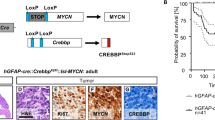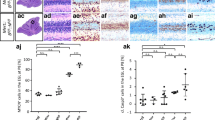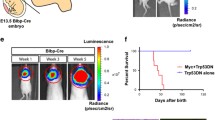Abstract
LIN28B is a homologue of the RNA-binding protein LIN28A and regulates gene expression during development and carcinogenesis. It is strongly upregulated in a variety of brain tumors, such as medulloblastoma, embryonal tumor with multilayered rosettes (ETMR), atypical teratoid/rhabdoid tumor (AT/RT), or glioblastoma, but the effect of an in vivo overexpression of LIN28B on the developing central nervous system is unknown. We generated transgenic mice that either overexpressed Lin28b in Math1-positive cerebellar granule neuron precursors or in a broad range of Nestin-positive neural precursors. Sections of the cerebellar vermis from adult Math1-Cre::lsl-Lin28b mice had an additional subfissure in lobule IV. Vermes from p0 and p7 Nestin-Cre::lsl-Lin28b mice appeared normal, but we found a pronounced vermal hypersublobulation at p15 and p21 in these mice. Also, the external granule cell layer (EGL) was thicker at p15 than in controls, contained more proliferating cells, and persisted up to p21. Consistently, some Pax6- and NeuN-positive cells were present in the EGL of Nestin-Cre::lsl-Lin28b mice even at p21, and we detected more NeuN-positive granule neuron precursors in the molecular layer (ML) as compared to control. Finally, we found some residual Pax2-positive precursors of inhibitory interneurons in the ML of Nestin-Cre::lsl-Lin28b mice at p21, which have already disappeared in controls. We conclude that while overexpression of LIN28B in Nestin-positive cells does not lead to tumor formation, it results in a protracted development of granule cells and inhibitory interneurons and leads to a hypersublobulation of the cerebellar vermis.




Similar content being viewed by others

References
Piskounova E, Polytarchou C, Thornton JE, LaPierre RJ, Pothoulakis C, Hagan JP, et al. Lin28A and Lin28B inhibit let-7 microRNA biogenesis by distinct mechanisms. Cell. 2011;147:1066–79.
Zhou J, Ng S-B, Chng W-J. LIN28/LIN28B: an emerging oncogenic driver in cancer stem cells. Int J Biochem Cell Biol. 2013;45:973–8.
Shinoda G, Shyh-Chang N, Soysa TY, Zhu H, Seligson MT, Shah SP, et al. Deficiency of Lin28 programs life-long aberrations in growth and glucose metabolism. Stem Cells. 2013;31:1563–73.
Yang M, Yang S-L, Herrlinger S, Liang C, Dzieciatkowska M, Hansen KC, et al. Lin28 promotes the proliferative capacity of neural progenitor cells in brain development. Development. 2015;142:1616–27.
Viswanathan SR, Powers JT, Einhorn W, Hoshida Y, Ng TL, Toffanin S, et al. Lin28 promotes transformation and is associated with advanced human malignancies. Nat Genet. 2009;41:843–8.
Molenaar JJ, Domingo-Fernandez R, Ebus ME, Lindner S, Koster J, Drabek K, et al. LIN28B induces neuroblastoma and enhances MYCN levels via let-7 suppression. Nat Genet. 2012;44:1199–206.
Spence T, Sin-Chan P, Picard D, Barszczyk M, Hoss K, Lu M, et al. CNS-PNETs with C19MC amplification and/or LIN28 expression comprise a distinct histogenetic diagnostic and therapeutic entity. Acta Neuropathol. 2014;128:291–303.
Weingart MF, Roth JJ, Hutt-Cabezas M, Busse TM, Kaur H, Price A, et al. Disrupting LIN28 in atypical teratoid rhabdoid tumors reveals the importance of the mitogen activated protein kinase pathway as a therapeutic target. Oncotarget. 2015;6:3165–77.
Mao XG, Hutt-Cabezas M, Orr BA, Weingart M, Taylor I, Rajan AK, et al. LIN28A facilitates the transformation of human neural stem cells and promotes glioblastoma tumorigenesis through a pro-invasive genetic program. Oncotarget. 2013;4:1050–64.
Taylor M, Northcott P, Korshunov A, Remke M, Cho YJ, Clifford S, et al. Molecular subgroups of medulloblastoma: the current consensus. Acta Neuropathol. 2012;123:465–72.
Hovestadt V, Jones DTW, Picelli S, Wang W, Kool M, Northcott PA, et al. Decoding the regulatory landscape of medulloblastoma using DNA methylation sequencing. Nature. 2014;26:537–41.
Schüller U, Zhao Q, Godinho SA, Heine VM, Medema RH, Pellman D, et al. Forkhead transcription factor FoxM1 regulates mitotic entry and prevents spindle defects in cerebellar granule neuron precursors. Mol Cell Biol. 2007;27:8259–70.
Tronche F, Kellendonk C, Kretz O, Gass P, Anlag K, Orban PC, et al. Disruption of the glucocorticoid receptor gene in the nervous system results in reduced anxiety. Nat Genet. 1999;23:99–103.
Dahlstrand J, Lardelli M, Lendahl U. Nestin mRNA expression correlates with the central nervous system progenitor cell state in many, but not all, regions of developing central nervous system. Dev Brain Res. 1995;84:109–29.
Hendrickson ML, Rao AJ, Demerdash ONA, Kalil RE. Expression of nestin by neural cells in the adult rat and human brain. PLoS ONE. 2011;6, e18535.
Sottile V, Li M, Scotting PJ. Stem cell marker expression in the Bergmann glia population of the adult mouse brain. Brain Res. 2006;1099:8–17.
Feng L, Hatten ME, Heintz N. Brain lipid-binding protein (BLBP): a novel signaling system in the developing mammalian CNS. Neuron. 1994;12:895–908.
Celio MR, Heizmann CW. Calcium-binding protein parvalbumin as a neuronal marker. Nature. 1981;293:300–2.
Maricich SM, Herrup K. Pax-2 expression defines a subset of GABAergic interneurons and their precursors in the developing murine cerebellum. J Neurobiol. 1999;41:281–94.
Weisheit G, Gliem M, Endl E, Pfeffer PL, Busslinger M, Schilling K. Postnatal development of the murine cerebellar cortex: formation and early dispersal of basket, stellate and Golgi neurons. Eur J Neurosci. 2006;24:466–78.
Engelkamp D, Rashbass P, Seawright A, van HV. Role of Pax6 in development of the cerebellar system. Development. 1999;126:3585–96.
Machold R, Fishell G. Math1 is expressed in temporally discrete pools of cerebellar Rhombic-Lip neural progenitors. Neuron. 2005;48:17–24.
Legué E, Riedel E, Joyner AL. Clonal analysis reveals granule cell behaviors and compartmentalization that determine the folded morphology of the cerebellum. Development. 2015;142:1661–71.
Bradley OC. Development and homology of the mammalian cerebellar fissures: Part II. J Anat Physiol. 1903;37:221–40.13.
Bradley OC. On the development and homology of the mammalian cerebellar fissures: Part I. J Anat Physiol. 1903;37:112–30.
Welker WI. The significance of foliation and fissuration of cerebellar cortex. The cerebellar folium as a fundamental unit of sensorimotor integration. Arch Ital Biol. 1990;128:87–109.
Mizuno Y, Ohama E, Hirato J, Nakazato Y, Takahashi H, Takatama M, et al. Nestin immunoreactivity of Purkinje cells in Creutzfeldt-Jakob disease. J Neurol Sci. 2006;246:131–7.
Dahmane N, Ruiz-i-Altaba A. Sonic hedgehog regulates the growth and patterning of the cerebellum. Development. 1999;126:3089–100.
Lewis PM, Gritli-Linde A, Smeyne R, Kottmann A, McMahon AP. Sonic hedgehog signaling is required for expansion of granule neuron precursors and patterning of the mouse cerebellum. Dev Biol. 2004;270:393–410.
Corrales JD, Blaess S, Mahoney EM, Joyner AL. The level of sonic hedgehog signaling regulates the complexity of cerebellar foliation. Development. 2006;133:1811–21.
Corrales JD, Rocco GL, Blaess S, Guo Q, Joyner AL. Spatial pattern of sonic hedgehog signaling through Gli genes during cerebellum development. Development. 2004;131:5581–90.
Tsialikas J, Romer-Seibert J. LIN28: roles and regulation in development and beyond. Development. 2015;142:2397–404.
Korshunov A, Ryzhova M, Jones DW, Northcott P, Sluis P, Volckmann R, et al. LIN28A immunoreactivity is a potent diagnostic marker of embryonal tumor with multilayered rosettes (ETMR). Acta Neuropathol. 2012;124:875–81.
Korshunov A, Remke M, Gessi M, Ryzhova M, Hielscher T, Witt H, et al. Focal genomic amplification at 19q13.42 comprises a powerful diagnostic marker for embryonal tumors with ependymoblastic rosettes. Acta Neuropathol. 2010;120:253–60.
Picard D, Miller S, Hawkins CE, Bouffet E, Rogers HA, Chan TSY, et al. Markers of survival and metastatic potential in childhood CNS primitive neuro-ectodermal brain tumours: an integrative genomic analysis. Lancet Oncol. 2012;13:838–48.
Li P, Du F, Yuelling LW, Lin T, Muradimova RE, Tricarico R, et al. A population of Nestin-expressing progenitors in the cerebellum exhibits increased tumorigenicity. Nat Neurosci. 2013;16:1737–44.
Lee A, Kessler JD, Read TA, Kaiser C, Corbeil D, Huttner WB, et al. Isolation of neural stem cells from the postnatal cerebellum. Nat Neurosci. 2005;8:723–9.
Acknowledgments
We are indebted to Michael Schmidt, Silvia Occhionero, and Marie-Christin Burmester for the excellent technical support. This work was supported by grants from the German Cancer Aid and the Wilhelm-Sander Stiftung.
Author information
Authors and Affiliations
Corresponding author
Ethics declarations
Conflict of Interest
The authors declare that they have no conflict of interest.
Ethical Approval
All applicable international, national, and/or institutional guidelines for the care and use of animals were followed.
Additional information
Annika K. Wefers and Sven Lindner contributed equally to this work.
Rights and permissions
About this article
Cite this article
Wefers, A.K., Lindner, S., Schulte, J.H. et al. Overexpression of Lin28b in Neural Stem Cells is Insufficient for Brain Tumor Formation, but Induces Pathological Lobulation of the Developing Cerebellum. Cerebellum 16, 122–131 (2017). https://doi.org/10.1007/s12311-016-0774-0
Published:
Issue Date:
DOI: https://doi.org/10.1007/s12311-016-0774-0



